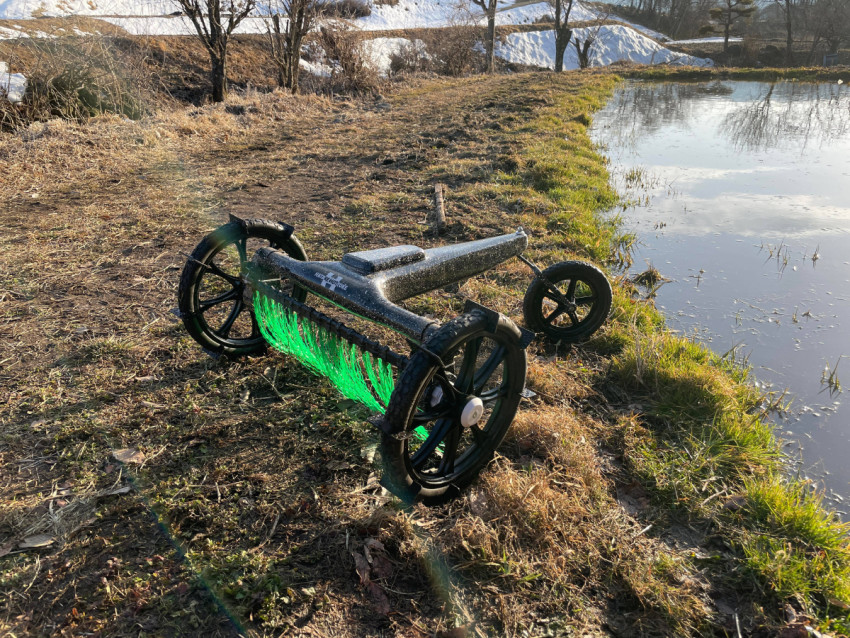A robot called Mizuni Goal has been designed to alleviate up to 80% of tough manual labor through automation and relieve the environmental burden faced by the farming industry.
While it normally takes at least 2 hours to manually “mud” one tan (1000m²) of rice field, Mizuni Goal can complete the task in about 20 minutes. In addition, through the robot’s consistent stirring of the rice paddy water, it essentially rids the need for herbicides and pesticides, and at the same time helps to spread oxygen equally to the roots of the rice plants – which is believed to improve the quality of rice.
Mizuni Goal, developed by creative agricultural company Hatake Hotke, was used in a start-up demonstration experiment in Nagano Prefecture, which is noted for having the highest number of small-scale farmers in Japan.
While manually "mudding" one tan (1000m2) of rice field takes at least two hours, Mizuni Goal can do it in around 20 minutes. Furthermore, the robot's constant stirring of the rice paddy water practically eliminates the need for herbicides and pesticides, while also assisting in the even distribution of oxygen to the roots of the rice plants, which is said to increase rice quality.
Mizuni Goal, a start-up demonstration experiment established by innovative agricultural enterprise Hatake Hotke, was employed in Nagano Prefecture, which is known for having the highest number of small-scale farmers in Japan.
In the Prefecture, around 100,000 small-scale farmers are registered.
As a result, it has been vulnerable to agricultural problems such as a lack of heirs and the abandonment of farmed land.
As part of the experiment, farmers in the prefecture will be able to rent the robot for 100,000 yen every season from 2022 forward. Sales will be based on direct input from farmers when the product is formally marketed in the spring of 2023.



 SoftBank Completes $41 Billion OpenAI Investment in Historic AI Funding Round
SoftBank Completes $41 Billion OpenAI Investment in Historic AI Funding Round  How to support someone who is grieving: five research-backed strategies
How to support someone who is grieving: five research-backed strategies  Novo Nordisk Stock Surges After FDA Approves Wegovy Pill for Weight Loss
Novo Nordisk Stock Surges After FDA Approves Wegovy Pill for Weight Loss  Boeing Secures $8.6 Billion Pentagon Contract for F-15 Jets for Israel
Boeing Secures $8.6 Billion Pentagon Contract for F-15 Jets for Israel  Cogent Biosciences Soars 120% on Breakthrough Phase 3 Results for Bezuclastinib in GIST Treatment
Cogent Biosciences Soars 120% on Breakthrough Phase 3 Results for Bezuclastinib in GIST Treatment  Sanofi to Acquire Dynavax in $2.2 Billion Deal to Strengthen Vaccines Portfolio
Sanofi to Acquire Dynavax in $2.2 Billion Deal to Strengthen Vaccines Portfolio  Asian Stock Markets Trade Narrowly as Year-End Volumes Thin, KOSPI Outperforms on Tech Rally
Asian Stock Markets Trade Narrowly as Year-End Volumes Thin, KOSPI Outperforms on Tech Rally  U.S. Stock Futures Slip as Year-End Trading Turns Cautious
U.S. Stock Futures Slip as Year-End Trading Turns Cautious  Lockheed Martin Secures Nearly $500 Million in U.S. and Allied Defense Contracts
Lockheed Martin Secures Nearly $500 Million in U.S. and Allied Defense Contracts  Lockheed Martin Secures $92.8M AEGIS Sustainment Contract from U.S. Navy
Lockheed Martin Secures $92.8M AEGIS Sustainment Contract from U.S. Navy  Trump Administration Probes Corporate DEI Programs, Raising Questions for Google Stock
Trump Administration Probes Corporate DEI Programs, Raising Questions for Google Stock  Gold Prices Ease After Record Highs as Dollar Firms, Broader Bullish Outlook Intact
Gold Prices Ease After Record Highs as Dollar Firms, Broader Bullish Outlook Intact  Vietnam’s EV Taxi Giant GSM Eyes Hong Kong IPO With $2–3 Billion Valuation
Vietnam’s EV Taxi Giant GSM Eyes Hong Kong IPO With $2–3 Billion Valuation  Oil Prices Slide in 2025 as Oversupply and Geopolitical Risks Shape Market Outlook
Oil Prices Slide in 2025 as Oversupply and Geopolitical Risks Shape Market Outlook  Vanda Pharmaceuticals Wins FDA Approval for New Motion Sickness Drug After Four Decades
Vanda Pharmaceuticals Wins FDA Approval for New Motion Sickness Drug After Four Decades 






























